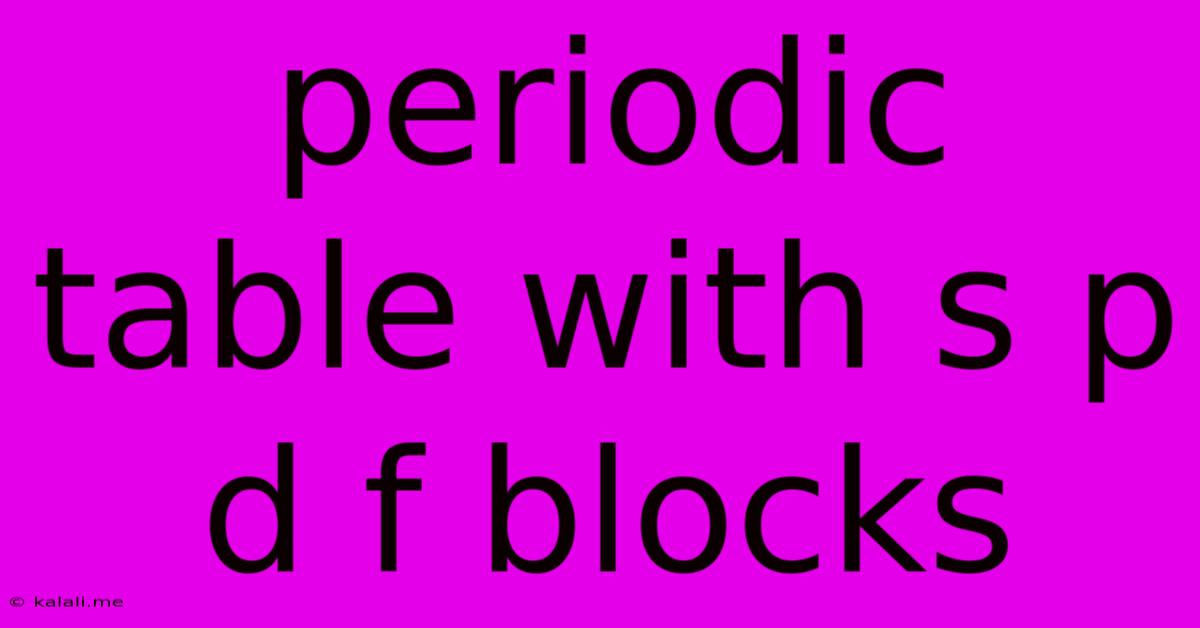Periodic Table With S P D F Blocks
Kalali
Jun 11, 2025 · 3 min read

Table of Contents
Understanding the Periodic Table: A Deep Dive into s, p, d, and f Blocks
The periodic table, a cornerstone of chemistry, organizes elements based on their atomic structure and properties. While memorizing the elements themselves is important, truly understanding the table requires grasping the underlying structure defined by its s, p, d, and f blocks. This article will delve into each block, exploring their electron configurations, characteristic properties, and placement within the periodic table.
The arrangement isn't arbitrary; it reflects the filling order of electron orbitals, directly influencing an element's chemical behavior. This understanding allows us to predict reactivity, bonding patterns, and other crucial chemical properties.
The s-block: Alkali and Alkaline Earth Metals
The s-block elements occupy the first two groups of the periodic table. These elements are characterized by their valence electrons residing in the s orbital. This gives them relatively simple electron configurations, resulting in predictable chemical behavior.
-
Group 1 (Alkali Metals): Highly reactive metals with one valence electron. Their reactivity increases down the group due to increasing atomic size and decreasing ionization energy. Examples include Lithium (Li), Sodium (Na), and Potassium (K).
-
Group 2 (Alkaline Earth Metals): Less reactive than alkali metals, but still quite reactive, possessing two valence electrons. Like alkali metals, their reactivity increases down the group. Examples include Beryllium (Be), Magnesium (Mg), and Calcium (Ca).
These elements are crucial in various applications, from everyday uses (like sodium in table salt) to more specialized industrial processes.
The p-block: A Diverse Collection
The p-block elements occupy groups 13-18, encompassing a diverse range of elements with varying properties. Their valence electrons occupy the p orbitals, leading to a wider spectrum of chemical behaviors compared to the s-block.
-
Nonmetals: Many of the p-block elements are nonmetals, showing a tendency to gain electrons to achieve a stable octet. These include halogens (Group 17), known for their high reactivity, and noble gases (Group 18), renowned for their inertness.
-
Metalloids: The p-block also houses metalloids, elements exhibiting properties of both metals and nonmetals. Silicon (Si) and Germanium (Ge) are prime examples, critical in semiconductor technology.
-
Metals: The left side of the p-block contains post-transition metals, such as aluminum (Al) and tin (Sn), which exhibit metallic properties but are less reactive than the s-block metals.
The p-block’s variety reflects the versatility of the p orbitals in forming different types of chemical bonds.
The d-block: Transition Metals
The d-block, encompassing groups 3-12, contains the transition metals. Their valence electrons occupy the d orbitals, leading to several characteristic properties:
-
Variable Oxidation States: Transition metals often exhibit multiple oxidation states, allowing them to form a wide array of compounds.
-
Catalysis: Many transition metals are excellent catalysts, facilitating chemical reactions without being consumed themselves.
-
Colored Compounds: Many transition metal compounds are brightly colored due to the absorption and emission of light by their d electrons.
These properties make transition metals essential in various applications, from industrial catalysis to the creation of vibrant pigments.
The f-block: Inner Transition Metals
The f-block elements, located below the main body of the periodic table, are the lanthanides (rare earth elements) and actinides. Their valence electrons occupy the f orbitals, leading to very similar chemical properties within each series. Many are radioactive.
-
Lanthanides: These elements are relatively abundant, yet their extraction and purification can be challenging. They're used in various applications, including lighting and magnets.
-
Actinides: Most actinides are radioactive and synthetically produced. They are primarily used in nuclear technology.
The f-block elements, while less familiar in everyday life, are crucial in specialized technologies.
Conclusion: A Unified Structure
The s, p, d, and f blocks provide a framework for understanding the periodic table's organization and the underlying principles governing elemental properties. By understanding the electron configurations and orbital filling, we can predict and explain the diverse chemical behaviors of the elements, highlighting the table's power as a fundamental tool in chemistry. This knowledge is critical for anyone studying chemistry, from introductory courses to advanced research.
Latest Posts
Latest Posts
-
How Many Slices Of Turkey In 2 Oz
Jul 01, 2025
-
Omnipoint Miami E License Llc Miami Fl
Jul 01, 2025
-
Mi Familia Fuera La M S Grande Correct Incorrect
Jul 01, 2025
-
How Much Is 20 Pounds Of Pennies Worth
Jul 01, 2025
-
How Much Does A Gallon Oil Weigh
Jul 01, 2025
Related Post
Thank you for visiting our website which covers about Periodic Table With S P D F Blocks . We hope the information provided has been useful to you. Feel free to contact us if you have any questions or need further assistance. See you next time and don't miss to bookmark.